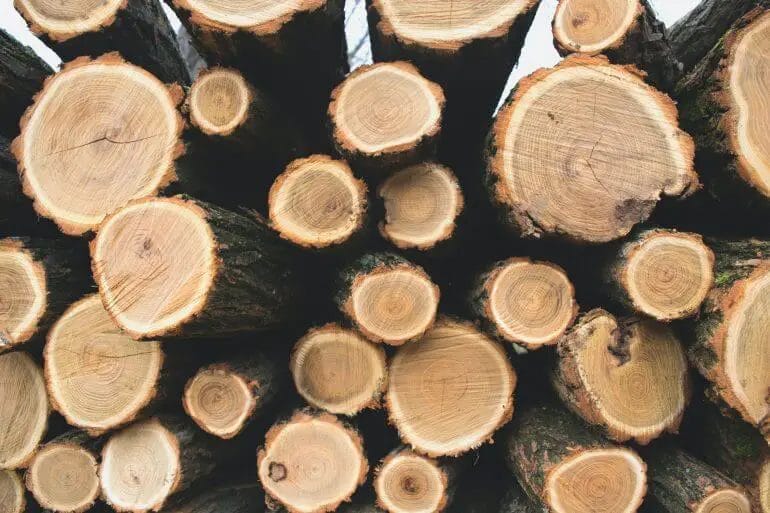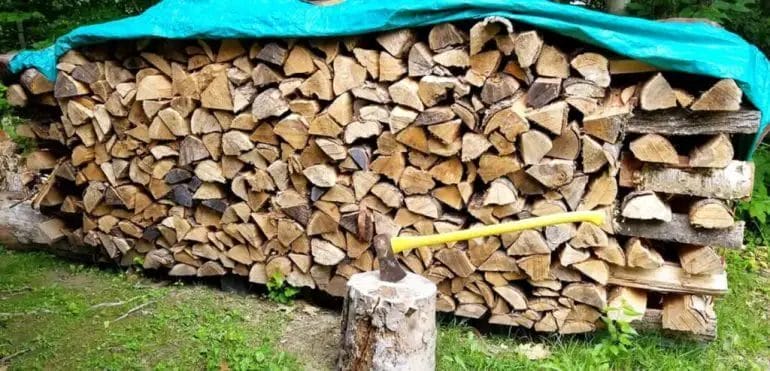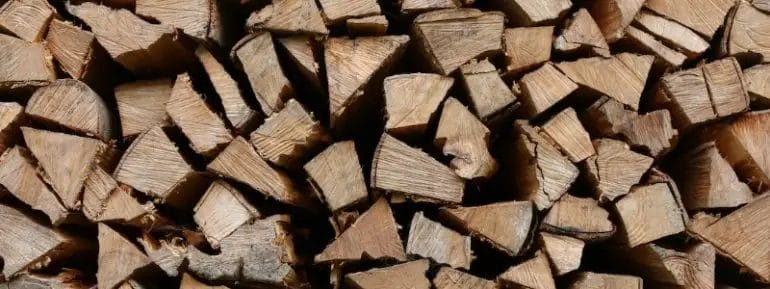A cord of wood can last anywhere from a few weeks to several months, depending on various factors.
These factors include the size of your living space, the efficiency of your heating system, and how often and at what temperature you burn the wood.

In general, a cord of hardwood can provide heat for an average-sized home for about 1 to 2 months, while a cord of softwood may last for a shorter duration.
It’s important to note that proper storage and seasoning of the wood can also affect its burn time, so it’s best to follow recommended guidelines to maximize its longevity.

Efficient Burning Techniques to Make a Cord of Wood Last Longer
When it comes to heating your home during the cold winter months, a wood-burning stove or fireplace can be an excellent option. However, the cost of firewood can quickly add up, and it’s essential to make the most of your investment. By using efficient burning techniques, you can make a cord of wood last longer, saving both money and resources. In this section, we will explore some tips and techniques to help you maximize the burn time of your wood.
1. Properly Seasoned Firewood
The key to efficient burning is using properly seasoned firewood. Green or freshly cut wood contains a high moisture content, which makes it harder to burn and produces less heat. It’s important to ensure that your firewood has been seasoned for at least six months to a year, allowing the moisture content to drop below 20%. Seasoned wood burns cleaner, hotter, and longer, reducing the amount of firewood you need to use.
2. Stacking Wood for Proper Airflow
Another essential aspect of efficient burning is properly stacking your firewood. When stacking, leave enough space between each log to allow for proper airflow. Good airflow promotes better combustion and ensures that the wood burns more evenly. Avoid tightly packing the logs together, as this can restrict airflow, leading to inefficient burning and wasted wood.
3. Using the Top-Down Burning Method
The top-down burning method is a popular technique that helps maximize burn time and efficiency. Instead of starting with newspaper or kindling at the bottom, this method involves placing larger logs at the bottom of the firebox, followed by smaller logs and kindling on top. When lit from the top, the fire gradually burns down through the layers, resulting in a slower and longer-lasting burn. Additionally, this method produces less smoke and ash, reducing maintenance and cleanup.
4. Managing the Airflow
Controlling the airflow is crucial for efficient wood burning. Too much air can cause the fire to burn too quickly, wasting wood, while too little air can suffocate the fire, resulting in a smoky and inefficient burn. Most wood-burning stoves and fireplaces have adjustable dampers or air vents that allow you to regulate the airflow. It’s important to find the right balance by adjusting the airflow to maintain a steady and efficient burn.
5. Optimal Fire Size
The size of your fire can also impact its burn time and efficiency. While it may be tempting to build a large fire to quickly warm up your space, smaller fires are more effective at conserving wood and providing longer burn times. A smaller fire allows for better control of the airflow and heat output, ensuring that the wood burns more slowly and efficiently.
6. Regular Maintenance and Cleaning
Regular maintenance and cleaning of your wood-burning appliance are essential for optimal performance. Over time, creosote can build up in the chimney or flue, reducing airflow and increasing the risk of a chimney fire. It’s recommended to have your chimney inspected and cleaned annually by a professional chimney sweep. Additionally, regularly removing ashes and debris from the firebox helps improve airflow and prevents the buildup of excess material that can hinder efficient burning.
7. Using a Fireplace Insert or Stove
If you are looking to maximize the efficiency of your wood-burning heating system, consider using a fireplace insert or a wood-burning stove. These appliances are designed to be more energy-efficient and offer better control over the combustion process. They can help you achieve higher burn temperatures, reduce heat loss through the chimney, and ultimately make your firewood last longer.
By following these efficient burning techniques, you can extend the burn time of a cord of wood, reducing the amount of firewood needed and saving money in the long run. Additionally, efficient burning is not only cost-effective but also environmentally friendly, as it reduces emissions and promotes sustainable wood usage. Implement these strategies and enjoy a cozy and efficient wood-burning experience throughout the winter season.

How to Properly Store and Season Wood for Maximum Longevity
Properly storing and seasoning wood is essential for maximizing its longevity. Whether you use wood for firewood, woodworking projects, or any other purpose, ensuring that it is well-preserved will save you time, money, and effort in the long run. In this section, we will discuss some important tips and techniques to help you store and season wood effectively.
1. Selecting the Right Wood
Choosing the right type of wood is the first step towards ensuring maximum longevity. Different wood species have varying characteristics, such as density, moisture content, and decay resistance. Hardwood species like oak, maple, or birch are generally more durable and less prone to decay compared to softwood species like pine or spruce. Selecting the right wood species for your specific needs is crucial.
2. Preparing the Storage Area
Before storing wood, it’s important to prepare the storage area properly. Here are some key considerations:
- Shelter: It’s ideal to store wood in a covered area or a shed to protect it from rain, snow, and excessive moisture.
- Elevation: Keep the wood off the ground by using pallets or a raised platform. This helps prevent moisture absorption from the soil.
- Air Circulation: Ensure that there is proper airflow around the stored wood to facilitate drying and prevent mold or fungal growth.
- Protection from Pests: Take measures to keep pests like termites or wood-boring insects away from the wood storage area.
3. Cutting and Splitting
Properly cutting and splitting the wood aids in the seasoning process by increasing its surface area and allowing moisture to evaporate more effectively. Here are some guidelines to follow:
- Length: Cut the wood into suitable lengths, typically 16-18 inches, depending on your needs and the size of your fireplace or wood stove.
- Splitting: Split the wood into smaller pieces using a maul or a splitting axe. This exposes the inner layers of the wood and promotes faster drying.
4. Seasoning the Wood
Seasoning is the process of drying the wood to reduce its moisture content. Properly seasoned wood burns more efficiently, produces less smoke, and generates more heat. Follow these steps to season your wood effectively:
- Stacking: Arrange the split wood in a neat and organized stack. Leave space between the logs for adequate airflow.
- Orientation: Stack the wood in a way that allows sunlight and wind to reach as much surface area as possible.
- Timeframe: Depending on the wood species, climate, and other factors, wood generally takes 6-12 months to season properly.
- Monitoring: Regularly check the moisture content of the wood using a moisture meter. Once the wood reaches a moisture content of 20% or below, it is considered well-seasoned.
5. Additional Tips
Here are a few additional tips to help you store and season wood effectively:
- Cover the Top: While allowing for airflow, covering the top of the wood stack with a tarp or a waterproof cover can protect it from excessive moisture.
- Remove Bark: Removing the bark from the wood accelerates the drying process by reducing moisture retention.
- Use Proper Ventilation: If you are using a woodshed or a storage unit, ensure adequate ventilation to prevent the buildup of moisture.
In summary, properly storing and seasoning wood is crucial for maximizing its longevity. By selecting the right wood, preparing the storage area, cutting and splitting the wood, and following the proper seasoning process, you can ensure that your wood remains in optimal condition for its intended use. With these tips in mind, you can enjoy the benefits of well-preserved wood for years to come.

Understanding Different Wood Types and Their Burn Rates
When it comes to heating your home or enjoying a cozy fire, choosing the right type of wood can make a significant difference. Not all wood types burn the same way, and understanding the burn rates of different wood types can help you make an informed decision. In this section, we will explore various wood types and their burn rates.
1. Hardwood vs. Softwood
Before diving into specific wood types, it’s essential to understand the difference between hardwood and softwood. Hardwood comes from deciduous trees like oak, maple, or birch, while softwood comes from coniferous trees like pine, fir, or cedar.
Hardwood is denser and has a higher energy content, making it burn slower and produce more heat over a more extended period. Softwood, on the other hand, burns faster and produces less heat but is easier to ignite.
2. Oak
Oak is one of the most popular hardwoods for burning due to its high energy content and slow burn rate. It produces a long-lasting fire with a steady heat output. Oak is readily available and provides excellent coals for cooking or warming.
It’s important to note that oak should be seasoned properly before use, as green or unseasoned oak can be challenging to light and produce excess smoke.
3. Maple
Maple wood is another hardwood option known for its excellent burning characteristics. Like oak, it burns slow and produces a steady, long-lasting fire. Maple also provides a pleasant aroma while burning.
It’s important to select well-seasoned maple wood to ensure optimal burning and minimize the production of smoke and creosote buildup in your chimney.
4. Birch
Birch wood is a popular choice for firewood due to its high heat output and easy ignitability. It’s classified as a hardwood but has a slightly faster burn rate compared to oak or maple. Birch wood burns hot and bright, making it ideal for starting fires or producing a burst of heat quickly.
However, birch wood burns relatively fast, so it may require more frequent fuel additions compared to slower-burning hardwoods.
5. Pine
Pine wood is a common softwood used for burning, especially for kindling or starting fires. It ignites quickly and produces a bright flame, making it ideal for getting your fire started. However, pine has a higher resin content, which can lead to a faster burn rate and increased creosote buildup.
It’s important to mix pine with hardwoods for a longer-lasting fire and to minimize the risk of excessive smoke or creosote formation.
6. Cedar
Cedar wood is another softwood commonly used for burning due to its pleasant aroma and easy ignitability. It burns relatively quickly and produces a crackling flame that adds to the ambiance of your fire.
While cedar is a popular choice, it’s important to note that it may produce more smoke compared to hardwoods. Proper ventilation is crucial when burning cedar to ensure adequate airflow and prevent smoke buildup.
7. Other Wood Types
There are numerous other wood types available for burning, each with its own unique burn characteristics. Some examples include cherry, hickory, walnut, and ash. These woods can provide different heat outputs, burn rates, and aromas, allowing you to select the wood type that best suits your needs and preferences.
In summary, understanding the burn rates of different wood types is essential for optimizing your fire’s performance. Hardwoods like oak, maple, and birch burn slower and produce more heat over a longer period, while softwoods like pine and cedar burn faster but are easier to ignite. By selecting the appropriate wood type for your needs, you can create a warm and inviting fire experience.
Tips for conserving wood and extending the lifespan of a cord
If you rely on wood as a source of heat during the colder months, it’s important to be mindful of how you use and conserve this valuable resource. Conserving wood not only helps the environment, but it also helps you save money in the long run. In this section, we will discuss some useful tips for conserving wood and extending the lifespan of a cord.
1. Store wood properly
To ensure that your wood remains in good condition and lasts longer, it’s essential to store it properly. Here are some tips:
- Stack your wood in a dry and well-ventilated area.
- Keep the wood off the ground by using pallets or a raised platform.
- Cover the top of the woodpile with a tarp or waterproof cover to protect it from rain or snow.
- Allow for airflow between the pieces of wood to prevent moisture buildup.
2. Season your wood
Seasoned wood burns more efficiently and produces more heat compared to green or unseasoned wood. Here’s how you can properly season your wood:
- Cut your firewood to the appropriate size, typically around 16 inches in length.
- Split the wood into smaller pieces to increase the surface area for faster drying.
- Stack the wood in a single row with space between the logs for air circulation.
- Store the wood in a dry area and let it season for at least 6-12 months.
3. Use the right burning techniques
The way you burn your wood can significantly impact its lifespan. Follow these burning techniques to conserve wood:
- Build small, hot fires instead of large, smoldering ones.
- Use dry kindling and newspaper to start the fire quickly.
- Open the damper fully to allow for proper airflow.
- Avoid overloading the firebox with too much wood at once.
- Regularly remove ashes to maintain proper airflow and prevent smoldering.
4. Maintain your wood-burning appliance
Proper maintenance of your wood-burning appliance can improve its efficiency and extend the lifespan of your wood. Here are some maintenance tips:
- Clean your chimney regularly to remove any creosote buildup.
- Inspect and replace gaskets to ensure a tight seal.
- Check for any cracks or leaks in the stove or fireplace.
- Ensure proper ventilation to prevent smoke from entering your home.
5. Supplement with alternative heating methods
To reduce your reliance on wood and conserve it for when it’s most needed, consider supplementing with alternative heating methods. These can include:
- Insulating your home to reduce heat loss.
- Using a programmable thermostat to regulate temperature.
- Investing in energy-efficient appliances.
- Exploring renewable energy options like solar or geothermal heating.
In summary, conserving wood and extending the lifespan of a cord is essential for efficient and cost-effective heating. By following these tips, you can maximize the use of your wood and reduce your environmental impact.
FAQs
How long will a cord of wood last?
The duration a cord of wood will last depends on several factors, such as the type of wood, weather conditions, and the efficiency of your fireplace or wood-burning stove. On average, a cord of wood can last between 1 to 2 months for an average-sized home with regular use.
Conclusion
In conclusion, the longevity of a cord of wood depends on various factors such as the type of wood, its moisture content, the size of the firewood pieces, and the frequency of usage. A well-seasoned cord of hardwood can last for several months when used efficiently and in moderation. However, it is important to note that individual burning habits and weather conditions can significantly impact the duration of time a cord of wood will last. To maximize the lifespan of your wood, ensure proper storage and handling to prevent moisture accumulation and promote efficient burning.